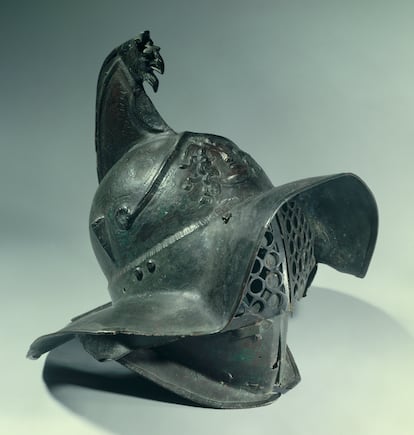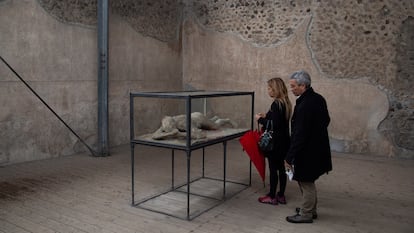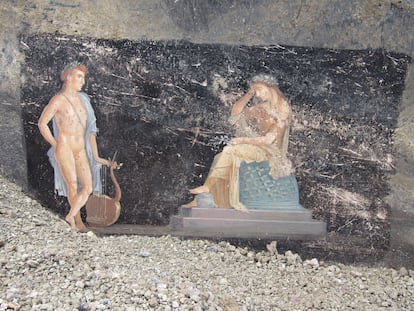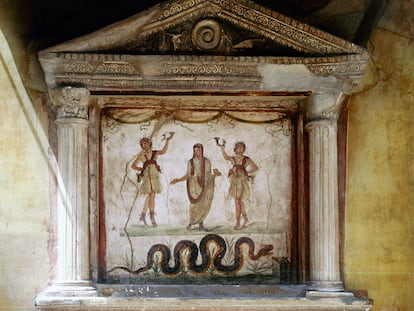‘It’s not all about the penis in Pompeii’: How to tour a city buried in objects, including a gladiator helmet, a charred bread loaf and a urinal
Archaeologist and author Rubén Montoya reviews the history of the famous location razed by the eruption of Mount Vesuvius. After wading through scores of artifacts, he says it was not the erotic destination some have made it out to be


Pompeii, a Roman City in 100 Objects describes the petrified city through a hundred very different items. Some are noble and precious, such as a gold bracelet, statues, paintings, a gladiator’s helmet; others are more prosaic, including a charred loaf of bread, a razor blade and a chamber pot. Each object introduces an aspect of the history and daily life of the city, offering a rounded view of Pompeii — and not just its past, but also its present and future with the archaeological challenges it faces, including mitigating the ravages of tourism and climate change. The book is a very enjoyable way to immerse oneself in a city that was buried beneath four to six meters of ash and pumice with the eruption of Mount Vesuvius in the year 79 AD.
Its author, Rubén Montoya, 32, has a PhD in archaeology besides being a historian and researcher who trained in Spain, Italy and the UK with the renowned archeologist Penelope Allison. He has spent long stretches of time excavating in Pompeii, a city he has felt irresistibly drawn to since he was a child when he was captivated by the Roman ruins in Segóbriga near his family home in Spain. His book is both informative and fun, appealing to a wide audience. For the neophyte, it is an excellent and very complete introduction to Pompeii, while for the more specialized reader, it is a great summary and update, with the various objects used as a hook to draw the reader in.
The objects allow Montoya to explain the link between Spartacus and Pompeii; the debate on whether there were Christians in the city; the fact that there are still unexploded bombs from World War II and the danger these can represent – the Allied bombers caused enormous destruction in the archaeological zone, it was not all the volcano’s work; the fact that the city had its own patron saint, the curiously demure Venus Pompeiana; and the possibility that any day now the villa that Cicero owned on the outskirts of the city (complete with its library!) might be unearthed. Also, there’s the curious fact that we have an inscription of a magistrate,Titus Suedius Clementus, who also left graffiti on the Colossi of Memnon in Egypt — another link between Pompeii and Egypt besides the famous temple of Isis. The author also explains that there is graffiti referring to inter-female relationships. In fact, throughout the book there is an effort to focus on the often-invisible women of Pompeii, not only its inhabitants but also the archaeologists. There is also mention that the fast food bars, known as thermopolium, had a bad reputation and customers could find themselves branded “a cocksucker” and so become embroiled in an altercation; or that a series of phalluses painted on the walls and on the pavement seem to be signposts to the brothels where further graffiti reveals the name of clients like Scordopordonicus, which has got to be a nickname because, although it looks like the name of a Greek merchant from the Asterix comic books, it actually means Mr Garlic Flatulence.
The first object selected by Montoya is the ring bearing the head of the mythological creature Silenus. It was discovered by Charles III of Spain in the excavations of Pompeii in the 18th century during his years as King Charles VII of Naples when he was known as “the archaeologist king,” at a time when it had still not been established that the site was truly Pompeii. A ballista shell — an ancient missile — indicates that Pompeii was besieged in 89 BC by the Roman army during the Social War, when the people of Pompeii joined forces with other towns in southern Italy against Rome. On the northwestern wall of the city, where the House of the Vestals is located, the impact of an attack that was “intense, tragic and destructive” is still visible as is the impact of the earthquake of 63 AD, 16 years before Mount Vesuvius erupted. In fact, part of the city was being restored when the volcano started spewing pumice and ash.

Montoya has included in his list of objects iconic artifacts such as the cast of the poor dog in Orpheus’ house as well as some of the molds of human victims, and the beautiful gladiator helmet. There is also an anchor, which indicates the maritime character of the city and reminds us about the search for its main port; a cart that introduces the issue of Pompeian traffic (they had the equivalent of pedestrian areas); while the chamber pot acts as an introduction to the matter of sewage and the 262 latrines found in Pompeii, plus the pressing question of whether slaves and their owners shared a latrine, there being just one per household. The charred loaf of bread suggests an element of day-to-day life as well as a reminder that 33 bakeries have been excavated. Other objects on Montoya’s list are the Indian statuette that indicates that Pompeii had a broad trading network; medical instruments — a clinic has been found in the city; dice and a bathtub.

Montoya begins by recounting his first visit to Pompeii in 2010, as a 19-year-old intern in an archaeological project run by the Complutense University of Madrid. He was a perfect candidate as he had already been classifying objects based on photographs during the entire previous year. “It was like living a dream,” says Montoya. He would subsequently return on many occasions to work in the city. “The common thread of the book is that each object is placed in context,” he explains. Referring to the fact that the book covers only 99 objects, he adds “The book itself is the 100th object.”
Excavating or consolidating the finds
According to Montoya, “Pompeii is a place where I am happy and feel safe.” It is also a place “that transcends archaeology” and that “allows us to touch the past and reflect on the future.” The author has the privilege of having access to Fabio Rufo’s house even at night. But he points out that today visits to Pompeii can be made virtually online, as the city has been completely digitized, house by house, room by room. He stresses that, thanks to new technology, we are seeing things that were once seen by the first travelers of the Grand Tour, who were able to contemplate the mark left by a glass of wine on a marble table.

Montoya draws our attention to the beauty of the Trojan-themed paintings recently found in a “black room” of a house located in Isula 10 of Regio IX. These, he says, are one more example of the wonders Pompeii’s houses conceal or are yet to reveal, as a third of the houses are still to be excavated. These cover approximately 20 hectares without counting the area outside the city walls, where the elite owned large villas. “Pompeii is always going to turn up surprises,” he says, although there is a debate over whether to continue excavating or focus on reinterpreting what has already been unearthed, with the use, for example, of AI.
Montoya stresses that we have a good understanding of the morphology of the eruption and the pyroclastic flows that destroyed Pompeii and nearby cities such as Herculaneum and Stabiae. He believes the volcano erupted in autumn rather than August and points out that there was, in fact, no lava in Pompeii. “It is disturbing to witness the level of pain and suffering that you perceive in Pompeii; people saw how everything around them was calcined, even glass and bronze melted.”
Montoya also points out that we tend to underestimate the scope of the eruption; the overwhelming 30-kilometer incandescent column that rose over Vesuvius and collapsed over Pompeii; the rain of stones; the terrible atmospheric pyrotechnics, though the hundred or so casts of the victims, including one of a dog, a pig and two horses, offer some insight. “There is something about pain that attracts us,” says Montoya. Perhaps it comes as a surprise to know that only an estimated 10% of the population died while the rest became refugees, having lost everything. We know of one inhabitant, Cornelius Fuscus, who ended his days in Dacia in charge of five legions in the war waged by Domitian.
Montoya’s favorite object is a gold bracelet in the shape of a coiled snake worn by a woman whose body turned up next to that of another woman and a girl who were all trying to take refuge in an inn. The bracelet bears an inscription on the inside, hidden from view, that reads “from the master to his slave,” and alludes to a love affair. “With that piece of jewelry, she would have seemed like a lady herself, but she was probably one of the many slaves who practiced prostitution. It is a fascinating object that offers insight into another aspect of Pompeian life.”
It is curious that among the 100 objects, there are none of the famous phalluses and the ubiquitous tintinnabulum — an assembly of bells in the shape of a bronze ithyphallic figure thought to ward off the evil eye — which furnish the Secret Museum of Naples. “I do address the world of sexuality, of course — there’s the bas-relief of Lucius Numinus’ bar with the woman, most likely a prostitute, on top of the man — but I purposely didn’t want to go all out on the penis; it’s not all about the penis in Pompeii as some seem to think,” says Montoya. “The image of the phallus was common in houses, in the streets, on the statues and altars of [the minor fertility god] Priapus, but it did not have the transgressive and scandalous meaning it has today. Sex was not taboo in Pompeii, and the fact that its representations can surprise us says more about us than it does about the Romans.”
Montoya points out some common misconceptions about Pompeii, such as thinking that it was a particularly erotic destination within the Roman world, or that it is a city frozen in time, “what is called the false Pompeian premise.” The eruption lasted 24 hours, but it buried a city in the process of continuous change, a place that was both dynamic and industrious. “It does not give us a fixed picture of immobility and stagnation — quite the opposite,” he says.
From the relative lack of written testimony at the time of the eruption — the testimony of the Plini is preserved — Montoya says that there are references from historians, including a visit by the emperor Titus to what was the ground zero of the catastrophe, as well as from poets such as Statius: “Where Vesuvius exploded with fury, pouring storms of fire.” But, certainly, there is a lack of eyewitness accounts. “It has to do with the resilience of the human being – we look forward,” explains Montoya. “It’s like with the pandemic, which we don’t even talk about anymore.”
Sign up for our weekly newsletter to get more English-language news coverage from EL PAÍS USA Edition
Tu suscripción se está usando en otro dispositivo
¿Quieres añadir otro usuario a tu suscripción?
Si continúas leyendo en este dispositivo, no se podrá leer en el otro.
FlechaTu suscripción se está usando en otro dispositivo y solo puedes acceder a EL PAÍS desde un dispositivo a la vez.
Si quieres compartir tu cuenta, cambia tu suscripción a la modalidad Premium, así podrás añadir otro usuario. Cada uno accederá con su propia cuenta de email, lo que os permitirá personalizar vuestra experiencia en EL PAÍS.
¿Tienes una suscripción de empresa? Accede aquí para contratar más cuentas.
En el caso de no saber quién está usando tu cuenta, te recomendamos cambiar tu contraseña aquí.
Si decides continuar compartiendo tu cuenta, este mensaje se mostrará en tu dispositivo y en el de la otra persona que está usando tu cuenta de forma indefinida, afectando a tu experiencia de lectura. Puedes consultar aquí los términos y condiciones de la suscripción digital.
More information
Últimas noticias
James Cameron: ‘For the films I like to make to continue to exist, we have to find a way to make them cheaper’
Families demand repatriation of bodies of Colombians who died in Ukraine: ‘This war is a slaughterhouse for foreigners’
Mexico’s missing people crisis casts a shadow over World Cup venue
ICE raids trigger school absenteeism and traumatize children: ‘They have been forced to leave their childhood behind’
Most viewed
- Christian Louboutin: ‘Young people don’t want to be like their parents. And if their parents wear sneakers, they’re going to look for something else’
- US sanctions against jailed cartel leader ‘El Marro’ highlight Mexico’s lack of control over its prisons
- Cartels in Mexico take a leap forward with narco-drones: ‘It is criminal groups that are leading the innovation race’
- Liset Menéndez de la Prida, neuroscientist: ‘It’s not normal to constantly seek pleasure; it’s important to be bored, to be calm’
- ‘El Limones’ and the growing union disguise of Mexican organized crime










































